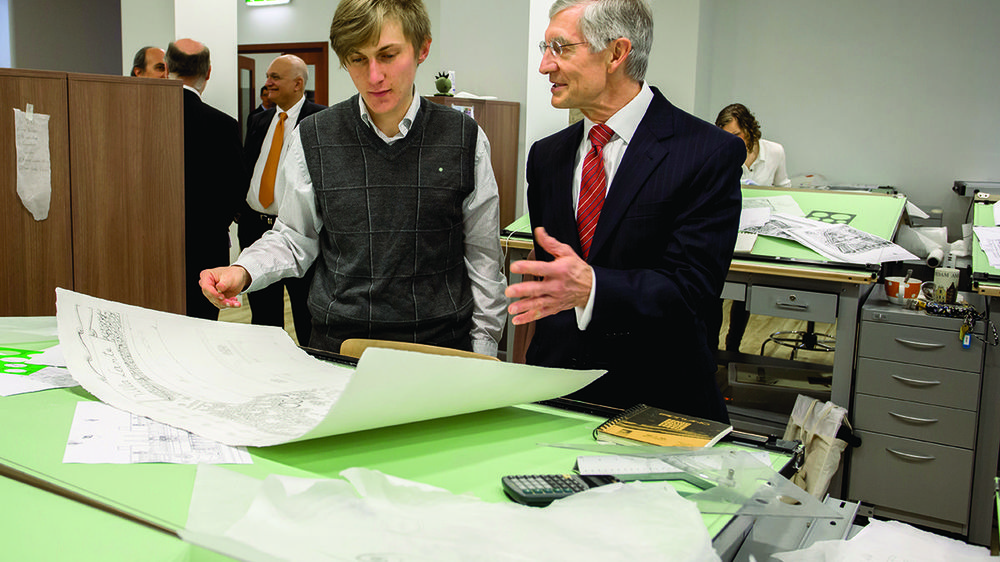Above, Provost Tom Burish with an architecture student studying in Rome in 2014.
In April, the School of Architecture will celebrate its Rome Studies Program’s 50th anniversary, including an academic conference and two days of reunion activities.
The program enables third-year architecture students and graduate students to spend time in Italy. The centerpiece of the architecture students’ time at the University, it’s the only foreign studies program at an American architecture school that’s required for all students.
“Frank Montana, the program’s founder, understood the importance of studying in Rome because of the incredible range of historic architecture and urban design it offered as a laboratory for our students for research and design,” says John Stamper, professor and associate dean of the school and the Rome program director from 1990 to 1999. “It is strategically located in the heart of Italy, and of course, there is the importance of being in close proximity to the Vatican, giving our students numerous opportunities to participate in papal Masses and tours of St. Peter’s Basilica and the Vatican Museums.”
The program has grown since it was founded in 1968, moving from its original quarters to the new Rome Global Gateway. The move doubled the size of its facilities and enriched the opportunities available. Currently 30 to 40 students study in Rome each academic year, with around 15 graduate students spending a semester there to study. The students have a variety of classes available to them as well as opportunities to travel on educational trips within the country.
“The two most important things students take away from their experiences in Rome is, first of all, the development of their sense of self-reliance for living and traveling in a foreign culture,” Stamper says. “Second is their exposure to a diverse range of architecture, from ancient and medieval to Renaissance and Baroque, which greatly enhances their visual repertoire and understanding of cities and cultures other than their own. It opens their eyes to new ways of living, especially the experience of living in a dense urban environment.”
Craig Tiller, now the senior director of project management for Facilities Design and Operations, who has worked on major University projects including the Walsh Family Hall of Architecture and the renovation and expansion of the Morris Inn, spent a year in Rome as a Notre Dame undergrad. “For me, the Rome program was a very powerful experience that ultimately reaffirmed my desire to become an architect. Going into the Rome year I wasn’t reconsidering my major, but I was seriously considering law school with the goal of pursuing a career in construction/contract law realizing my strengths were not in creative design. My Rome year experience and specifically my exposure to the abundance of historical architecture and art, coupled with great faculty like Richard Piccolo and Jeffrey Blanchard, convinced me that my original pursuit was the right one for me.”
Doug Marsh, vice president and University architect, has led the design and construction of more than 40 buildings on campus to date. He had a similar transformative experience in Rome as a student. “The time I spent in Rome was an emotion-filled experience which forever impacted my life,” he says. “Being from South Bend, it was the first time I had genuinely lived away from my family, so the first semester for me was about growing up. It was during the second semester when living amid the Eternal City and led by the Holy Spirit that my passion for building was lit. I will be forever grateful to Notre Dame, Father Ted and Frank Montana for founding the Rome Studies Program.”
The 50th anniversary celebration will take place April 10-13 at the Rome Global Gateway. Stamper and Dean Michael Lykoudis will be there, as well as members of the University administration.
In his years as director, Stamper recognized the powerful effect of the program on his students. “The students all form close friendships with their classmates, something they retain throughout their lives. They particularly appreciate the field trips and the walking tours of Rome, where they get to learn about great historical buildings and places firsthand. The experiences they gain in Rome invariably influence the work they do throughout their careers in architecture or related fields in the arts. It gives them an understanding of what it means to build livable communities, sustainable environments — not to mention beautiful architecture.”
